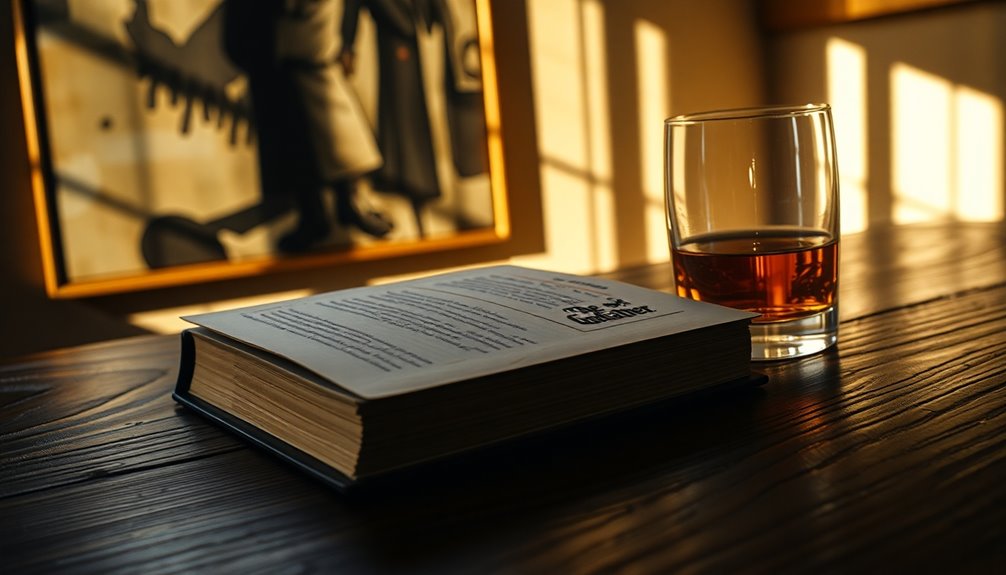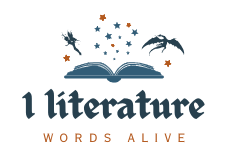If you're looking for a fresh perspective on "The Godfather," you'll find it a gripping exploration of loyalty and power. Mario Puzo crafts a narrative that unravels moral complexities within the Corleone family. Set in post-World War II America, it raises questions about ambition and corruption. Michael Corleone's transformation is a powerful focal point, showcasing the intertwining of family ties and crime. Stick around to uncover deeper insights into the characters and their journeys.
Overview of The Godfather

"The Godfather" stands as a cornerstone of crime fiction, offering a gripping look into the intricate world of the Corleone family. Written by Mario Puzo and published in 1969, this novel explores the dynamics of the fictional mafia family in post-World War II New York.
Starting at Don Corleone's daughter, Connie's wedding, the narrative spans from 1945 to 1955, capturing the family's rise amid complex criminal enterprises. Key themes like loyalty, power, and moral decline resonate throughout the story, reflecting American immigration and societal corruption. The family's struggle for dominance mirrors the resilience against extreme adversity seen in other historical narratives, such as Louis Zamperini's survival during WWII, where the collective action of individuals against oppressive forces played a crucial role.
The Godfather masterfully intertwines multiple character arcs, showcasing vivid development and the dualities within each personality. Its critical acclaim cements The Godfather's status as a modern masterpiece that reshaped organized crime storytelling. Additionally, the novel's exploration of systemic racism parallels the themes of social justice found in contemporary literature, highlighting the broader societal issues that persist in America.
Author Background and Context
Mario Puzo's journey as a writer profoundly shaped the narrative and themes of "The Godfather." Born to Italian immigrants in 1920, Puzo's upbringing immersed him in the complexities of immigrant life, which deeply influenced his portrayal of the mafia. His experiences and struggles led him to explore themes that resonated with many.
Here are a few key aspects of Puzo's background:
- Cultural Insights: Growing up in a tight-knit Italian community, Puzo gained a nuanced understanding of family loyalty and honor, paralleling the historical context of familial obligations seen in traditional societies. His writing reflects the enduring strength found in perseverance against poverty and adversity, similar to Dickens' thematic explorations.
- Financial Struggles: Before his breakthrough, Puzo faced financial instability, fueling his drive to create an enthralling story.
- Societal Reflections: The late 1960s context allowed Puzo to investigate the darker sides of power and crime, making his work relevant and impactful. Additionally, Puzo's narrative reflects the struggles of marginalized voices within society, illuminating the complexities of their experiences.
Setting and Timeline

Set primarily in New York City during the years following World War II, "The Godfather" immerses you in a world of family, power, and crime.
The timeline spans from 1945 to 1955, opening at the wedding of Don Vito Corleone's daughter, Connie. This event sets the stage for the cultural and familial backdrop that defines the story.
As you explore the setting, you witness the rise of organized crime amid significant societal changes, reflecting the complexities of immigrant experience in America. The narrative echoes themes of social injustice that resonate through historical struggles faced by marginalized communities and highlights the systemic oppression that shapes the characters' decisions and identities.
The contrast between Sicilian traditions and the American landscape reveals a rich tapestry of life in post-war America.
The depiction of the 1940s and 1950s highlights the moral decline and corruption prevalent in both law enforcement and societal institutions during that era.
Plot Summary and Key Events
In "The Godfather," you witness the complex dynamics of the Corleone family as they navigate power and loyalty.
Key turning points, like Michael's shift from outsider to leader, showcase the intense struggles within the family. This transformation mirrors the darker aspects of ambition seen in rivalries such as that between Kane and Abel.
As you follow their journey, you'll see how personal relationships intertwine with ruthless decisions that shape their fate. The narrative echoes themes of ambition and rivalry, revealing how the pursuit of power can lead to both success and destruction. This intricate web of relationships highlights the consequences of choices that define individual destinies.
Corleone Family Dynamics
The intricate dynamics of the Corleone family serve as the backbone of "The Godfather," highlighting the tensions and loyalties that define their relationships.
As you explore their world, you'll see:
- Don Vito Corleone's authoritative control, balancing fear and favors to maintain loyalty.
- Michael Corleone's transformation from a war hero to a key player in the mafia, driven by an assassination attempt on his father.
- The constant power struggles and betrayals between Michael, Sonny, and Fredo, which shape the family's destiny.
These layers of loyalty and conflict not only illustrate the Corleone family's complexity but also set the stage for their inevitable downfall, making their story both compelling and tragic.
Key Turning Points
While the novel opens with the joyous celebration of Connie Corleone's wedding, it quickly evolves into a tale of power, betrayal, and transformation.
One of the key turning points occurs when Michael Corleone, initially an outsider, takes decisive action to protect his father after an assassination attempt. This moment marks his reluctant entry into the mafia world.
The brutal murder of Sonny Corleone further escalates the stakes, pushing Michael to embrace his family's violent legacy. As he orchestrates revenge against their enemies, Michael's calculated killings signify his complete immersion in this dark lifestyle.
Ultimately, he consolidates power, reflecting loyalty's cost and moral decay, alienating his wife Kay as he fully assumes the role of Don Corleone.
Character Development and Dynamics

In "The Godfather," you watch Michael Corleone transform from a hesitant outsider to a ruthless leader, showcasing the dark allure of power. Meanwhile, Don Vito Corleone's unique leadership style blends kindness with a fierce protectiveness, shaping his family's identity and their place in the mafia world. This dynamic between father and son reveals the complexities of loyalty and the heavy costs of ambition. The narrative also reflects on the dangers of tyranny, emphasizing how power can corrupt even the most principled individuals. Furthermore, the story illustrates the relentless pursuit of desires, revealing how ambition can lead to a chilling atmosphere where personal relationships unravel. The exploration of moral complexities in the characters' decisions further enhances the story's depth.
Transformation of Michael Corleone
As Michael Corleone navigates the treacherous waters of his family's criminal empire, you witness a profound transformation that starkly contrasts with his initial intentions.
Initially, Michael seeks a legitimate life, but circumstances pull him deeper into the underworld. His journey can be summarized in three key phases:
- Reluctant Outsider: He distances himself from the family business, aiming for respectability.
- Catalyst for Change: An assassination attempt on his father forces Michael to retaliate, marking his entry into organized crime.
- Ruthless Leader: By the novel's end, Michael fully embraces his role as the Corleone head, making morally questionable decisions that alienate him from loved ones.
This transformation encapsulates Michael Corleone's tragic arc and the corrupting power of loyalty and crime.
Don Vito's Leadership Style
Michael Corleone's transformation starkly contrasts with the leadership style of his father, Don Vito Corleone.
Don Corleone embodies charisma and strategic thinking, commanding respect through loyalty rather than fear. He sees his associates as family, fostering a close-knit community that strengthens commitment to the Corleone legacy.
While Don Vito uses calculated violence sparingly, preferring negotiation and diplomacy, his principled approach highlights the importance of honor in the mafia. He balances fear and affection, cultivating strong personal relationships, which enhances his influence.
This dynamic is further emphasized when compared to Sonny's impulsive leadership style, showcasing the complexities of power within the Corleone family and the broader criminal world.
Don Corleone's legacy lies in his ability to lead with both strength and compassion.
Major Themes Explored
While exploring the major themes of "The Godfather," you'll find that loyalty stands out as a driving force in the narrative. This theme intertwines with several others, creating a rich tapestry of moral complexity.
Here are three key themes you'll encounter:
- Sicilian Honor vs. Brutality: The contrast highlights the respect and violence inherent in mafia life, showcasing the characters' internal struggles.
- Corruption of Power: Michael Corleone's journey illustrates how ambition can corrupt, transforming him from an innocent outsider to a ruthless leader.
- Societal Corruption: The story reflects on the immigrant experience, revealing how the mafia emerges as a response to systemic failures in law enforcement and governance.
These themes emphasize the moral ambiguity and deep consequences faced by the characters throughout the narrative.
Writing Style and Structure
Puzo's writing style in "The Godfather" complements its intricate themes, weaving together narrative and dialogue to create an engaging experience. His heavily expository approach blends character-driven stories with rich dialogue, allowing you to explore the complex lives of the Corleone family.
The book's structure, featuring interconnected tales, enhances your understanding of each character's motivations and dynamics. While the writing is accessible, it occasionally veers into subplots that add depth but can slow the narrative pace.
Puzo's portrayal of characters as multifaceted businessmen rather than mere criminals enriches the story, though it sometimes disrupts the overall momentum. This balance of detail and dialogue creates a vivid, immersive world that keeps you invested in the unfolding drama.
Strengths of the Novel
One of the novel's greatest strengths lies in its vivid portrayal of New York's criminal underworld, drawing you into the complex dynamics of mafia life and family loyalty.
The strengths of the novel, *The Godfather*, include:
- Engaging Storytelling: Mario Puzo blends fiction with factual references, creating a realistic narrative that resonates with contemporary issues.
- Multifaceted Characters: Each character showcases both dark and light sides, adding emotional depth and avoiding two-dimensional portrayals.
- Exploration of Themes: The book investigates power, morality, and the consequences of choices, offering reflective insights into human behavior and relationships.
These elements make *The Godfather* not just a crime story, but a profound exploration of the human condition, ensuring you remain captivated throughout.
Critiques and Limitations
Despite its many strengths, *The Godfather* has its share of critiques and limitations that some readers can't overlook.
Many feel the book lacks a continuous storyline, resulting in a disjointed narrative that diminishes engagement as you progress. While the initial plot is enthralling, it loses cohesion, leaving you wanting more.
Michael Corleone's character development also falls short, as his transformation isn't explored deeply enough for many readers.
Additionally, some side character backstories come off as unnecessary padding, slowing the pacing and detracting from the main storyline.
While certain emotional scenes can evoke strong reactions, such as nightmares, this varied emotional impact highlights the book's limitations, reminding you that not every aspect resonates equally with everyone.
Cultural Impact and Legacy
When you think about crime fiction, "The Godfather" likely comes to mind as a foundational piece that shaped the genre.
Its vivid representation of Mafia culture not only influenced public perception but also set a standard for how these stories are told in literature and film.
You can see its legacy in countless adaptations and works that continue to explore similar themes of loyalty and power.
Influence on Crime Fiction
While many crime novels explore the dark underbelly of society, "The Godfather" has uniquely shaped how organized crime is portrayed in literature. Its profound impact resonates through various elements:
- Character Development: Mario Puzo's rich characters inspire authors to explore complex themes of family loyalty and moral ambiguity.
- Tropes and Themes: The book established tropes that have become standard, influencing countless narratives in crime fiction.
- Cultural Resurgence: With over 12 million copies sold by 1975, its success sparked renewed interest in mafia-themed literature, paving the way for future works.
The themes of power dynamics and corruption in "The Godfather" continue to influence modern storytelling, ensuring its legacy endures in the domains of both literature and popular media.
Representation of Mafia Culture
The portrayal of mafia culture in "The Godfather" captivates readers by blending romance and reality, making the complexities of organized crime both alluring and thought-provoking.
Through the lens of the Corleone family, you see archetypes that shape how we view mafia characters today. Puzo's narrative doesn't just romanticize; it reveals the moral ambiguities and brutal realities of this lifestyle.
It reflects the historical rise of the mafia among immigrant communities, showcasing themes of loyalty and the darker sides of the American Dream. The Sicilian honor and family dynamics depicted resonate deeply, fostering a nuanced understanding of crime.
Ultimately, "The Godfather" has become a cornerstone of crime literature, inspiring ongoing discussions about power and morality in our society.
Memorable Quotes
Memorable quotes from "The Godfather" resonate deeply, capturing the essence of its themes and characters. Each line reveals insights into the world of the Corleone family, making you reflect on power, loyalty, and morality.
Here are three standout quotes that embody these ideas:
- "I'm gonna make him an offer he can't refuse." – This line encapsulates the persuasive tactics within the mafia.
- "Never hate your enemies. It affects your judgment." – A reminder to stay clear-headed amid conflict.
- "A man who doesn't spend his time with his family can never be a real man." – This emphasizes the importance of family loyalty, a key theme in the Godfather by Mario.
These quotes linger in your mind, enriching the overall narrative.
Comparison to Film Adaptation
When you compare the book to the film adaptation, you'll notice key differences in character representations.
The film simplifies certain characters and subplots, prioritizing the core narrative while still maintaining the story's integrity.
This streamlined approach enhances the cinematic experience but leaves out some depth found in Puzo's original work.
Character Representations Differences
While both the novel and film adaptation of "The Godfather" portray complex characters, the book explores deeper into their representations, offering a richer understanding of their motivations and conflicts.
Mario Puzo intricately develops characters that stand out in the book:
- Michael Corleone's transformation is a profound journey, highlighting his moral struggles that the film glosses over.
- Fredo Corleone's vulnerabilities are fleshed out, showing his insecurities and desire for respect, unlike the film's more simplistic portrayal.
- Don Vito Corleone's backstory reveals him as a benevolent patriarch, contrasting with the film's iconic yet superficial depiction.
These layers create a more nuanced view of the Corleone family dynamics, enhancing emotional stakes that the film adaptation overlooks.
Narrative Integrity Preservation
Although the film adaptation of "The Godfather" condenses certain plotlines, it effectively preserves the narrative integrity of Mario Puzo's novel. Key characters like Vito and Michael Corleone retain their depth, with the film employing visual storytelling to highlight their moral complexities and family dynamics.
While significant subplots, such as those involving Nino Valenti and Lucy Mancini, are omitted or altered, the core themes of family loyalty and power remain intact. The novel's climax, featuring simultaneous assassinations alongside a baptism, mirrors the film's execution—with irony underscoring Michael's transformation.
Though the book offers deeper insights through exposition, the film captures Michael Corleone's guilt and its relational impact through powerful visuals and dialogue, showcasing a masterful adaptation of Puzo's work.
Reader Experience and Engagement
Immersion is a key element of the reader experience in "The Godfather." As you explore the vivid descriptions of the Corleone family's world, you can't help but feel transported into the gritty realities of mafia life.
This deep engagement is driven by:
- Emotional Connections: You resonate with Michael Corleone's tragic transformation and the weight of loyalty and morality.
- Complex Family Dynamics: Puzo weaves relatable human experiences with the complexities of power and ethical compromises.
- Character Backstories: Rich explorations of character motivations enhance the narrative depth, keeping you invested.
Recommendations for Further Reading
If you found "The Godfather" fascinating, you'll likely enjoy exploring more literature that investigates the intricacies of mafia life and family dynamics.
Start with "The Family" by Mario Puzo, which serves as a prequel, diving into the origins of the Corleone family.
For a gripping true crime perspective, check out "Wiseguy" by Nicholas Pileggi, chronicling mobster Henry Hill's life and inspiring "Goodfellas."
You might also appreciate "Donnie Brasco: My Undercover Life in the Mafia" by Joseph D. Pistone, where an undercover agent's experiences mirror the drama of Puzo's work.
Finally, "The Sopranos" by David Chase expands on similar themes, making it a must-read for fans of mafia narratives.
Conclusion
To sum up, "The Godfather" offers a gripping exploration of power and family loyalty that resonates with readers even today. Did you know that the novel has sold over 9 million copies worldwide since its release in 1969? This staggering figure highlights not just its enduring appeal but also its profound impact on popular culture. If you haven't yet experienced Mario Puzo's masterpiece, now's the perfect time to plunge into this iconic tale of the Mafia.



